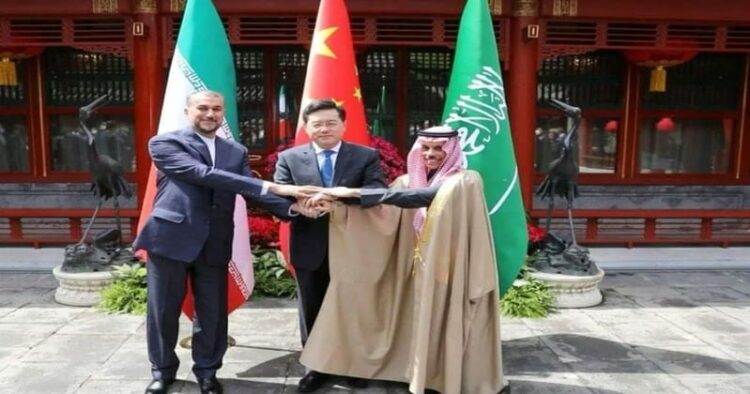The Foreign Ministers of Iran and Saudi Arabia have met in Beijing in the first formal meeting of the two countries’ top diplomats in seven years. The meeting was the highest-level bilateral gathering of officials from Iran and Saudi Arabia after the two sides agreed to reestablish diplomatic ties following talks in Beijing in March.
China’s top diplomat Wang Yi called the agreement a “victory for dialogue and a victory for peace,” and framed it as part of China’s “constructive role in facilitating the proper settlement of hot-spot issues around the world,” according to a statement from China’s Foreign Ministry in March when the deal was announced.
Recently, Saudi Arabia’s state-run broadcaster Al Ekhbariya released brief footage of the meeting showing Prince Faisal bin Farhan and his Iranian counterpart, Hossein Amir-Abdollahian. A video released by Saudi state media displayed the two Ministers joining hands while posing for photos. Chinese Foreign Minister Qin Gang was standing in the middle.
They discussed reopening the embassies and consulates of the two countries, Iran’s foreign ministry said in a statement. The two sides, who were previously staunch adversaries and severed diplomatic relations in 2016, also agreed to examine ways to expand their cooperation, including the resumption of flights, mutual trips from official delegations and the private sector, and facilitating visas, according to their statement, released by Iran.
“The Foreign Ministers of the Islamic Republic of Iran and Saudi Arabia negotiated and exchanged opinions with the emphasis on the official resumption of bilateral relations and the executive steps towards the reopening of the embassies and consulates of the two countries,” the statement said.
In a tweet, Amirabdollahian said that in the meeting with his Saudi counterpart, “emphasis on stability, sustainable security and regional development” were among the issues agreed upon and “on the common agenda.”
The resumption of relations between the two countries has been broadly perceived as a diplomatic victory for China in a Gulf region that has long been considered part of the US’ domain of influence. Analysts have observed that perhaps West Asia is now looking at a new order run by China.
However, jumping to the conclusions based on developing inferences is premature. It is a time-consuming process. Things are still materialising, not completely stabilised. So, the perception of Chinese diplomacy being the champion of peace-conflict resolution should be rationalised. To look at the development in an objective way, one needs to lower down the Chinese rhetoric.




















Comments